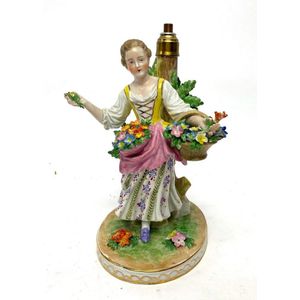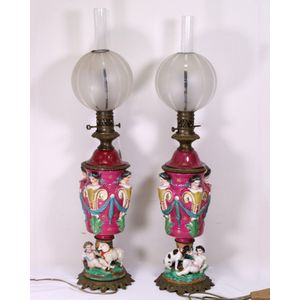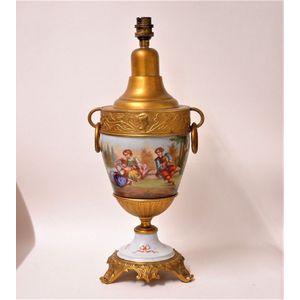
Dresden Porcelain Flower Seller Table Lamp, 24 cm Height
A Dresden porcelain table lamp, figure of a flower seller, unwired, height 24 cm

Dresden Porcelain Caryatid Lamps with Ormolu Base
A fine pair of Dresden 19th century porcelain lamps each of baluster form with a continuous band of moulded caryatids in 18th century in period dress, below a nude female figure with a hound and a lamb on ormolu base, approx. 85 cm high overall.

Dresden Porcelain Parrot Table Lamp, 19th Century
A Dresden porcelain parrot figured table lamp, 19th century, 33 cm high (parrot only)

18th Century Style Dresden Figural Table Lamps
Pair mid 20th century Dresden figural table lamps, modelled in the 18th century manner with gent and his companion on separate pedestal bases, 48 cm height

Classical Porcelain and Ormolu Lamp Base
A 20th century European porcelain and ormolu classical lamp base in the Dresden manner, classical riverside figures finely hand painted to the body, ormolu mounts including female bust in profile and captured ring handles. Height 44 cm.

Dresden Dancing Lamp with Lithophane Shade
Dresden 'Ring Around the Rosie' lamp modelled with four young adults dancing around a tree form body, on a floral applied ground, all on a scrolled floral base, having a four lithophane panelled shade, decorated with gold accents & flowers, with a flower…

Dresden Dancing Lithophane Lamp
Dresden 'Ring Around the Rosie' lamp modelled with four young adults dancing around a tree form body, on a floral applied ground, all on a srcolled flroral base, having a four lithophane panelled shade, decorated with gold accents & flowers, with a flower…

Dresden Rococo Oil Lamp with Floral Encrustation
An early 20th century Dresden floral encrusted oil lamp by the Carl Thieme Factory, in the Rococo taste with the reticulated stem. 87 cm high.

Dresden China Urn Lamps with Cream Silk Shades
A pair of Dresden china lamps with shades, urn form white and gilded lamp bases with oval cream silk shades with trims; blue backstamp underside. Height 45 cm

Von Stierholz Dresden Porcelain Table Lamp with Pierced Shade
A Von Stierholz Dresden porcelain table lamp with pierced shade, marked to base. Height 43 cm.

Dresden Children Figural Lamp
Dresden figural lamp decorated with figures of children at play. Height 42 cm

Dresden Electric Lamp with Ornate Porcelain Shade
A good vintage Dresden electric lamp, base with figures of 5 children hand in hand and ornate pierced porcelain shade, with four lithophane panels, two light globe fittings, 43 cm high approx.

 Loading more...
Loading more...